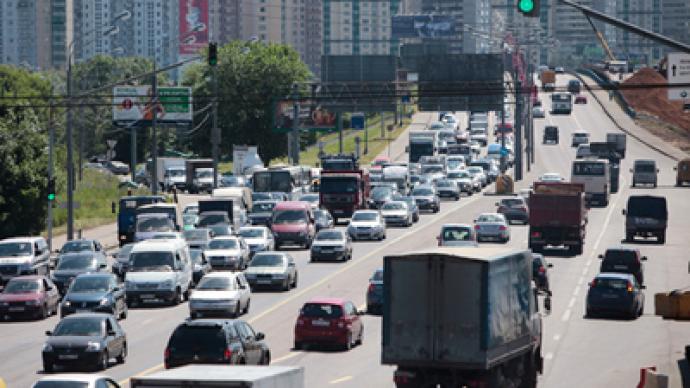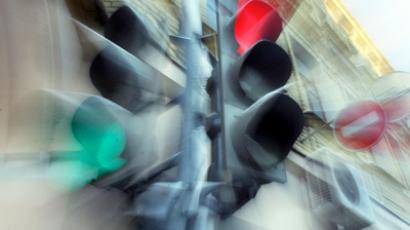Coming to grips with the costs of Moscow traffic

With Moscow roads legendary for their congestions and chaos and the costs they impose on business needing to use them, Business RT talked to Erwin Toplak, Chief Operating Officer of global traffic management systems provider KapschTrafficCom Austria.
RT:How big an impact could have more effective traffic management have in Moscow?ET:“London and Stockholm, which are mega poliscities similar to Moscow, have managed to reduce traffic by up to 22% by installing a Road Pricing Scheme. Thisis a very effective tool to reduce the number of cars using the roads. A fee, charging for city entrance and road usage, will on the one hand generate revenues, and on other change driver behaviour, thereby lowering car numbers and reducing congestion. Figures from London, Stockholm and many Italian cities show that it works. Increasing traffic and also lack of funds will make congestion charges a current topic in almost every major European city in the coming years. In many places, politicians tend to shy away from additional costs for vehicle drivers, who form an important part of the electorate. Closest to reaching a decision is the city of Gothenburg in Sweden. But also Helsinki, Copenhagen, Porto, Zurich and Athens are considering congestion charges.”RT:How do Moscow's traffic problems compare with other mega cities around the world?ET:“Moscow is among the largest urban centres in Europe, with up to 16 million people during the day, and a large number of cars, about 6 million, which is also growing rapidly.This results in very high traffic density, meaning Moscow needs a good road and public transport scheme. Mobility for people and goods is a necessity of life in any city. We need to understand how the traffic jams you mention arise – It is a lack of roads, or, too many cars in use, or a combination of both.Mega polis cities of the world have certain common characteristics. Any mayor of mega polis cities should follow the best practice for sustainable traffic: Reduce congestion, reduce fatalities, reduce the negative impacts of transport on the environment, and ensure that the financing of road infrastructure is in right order.”RT:How much would an effective traffic management system cost, and how long would it take to implement?ET:“First of all, one needs to make much better use of existing infrastructure. The role of an effective traffic management system must be defined at the state level, and they should become part of the planning system for infrastructure development. It has long been proven in various examples that an effective traffic management system allows more effective use of the road network and better management of traffic can increase its capacity by 20-25%. Instead of building new roads to increase capacity of the road network it may be better to use intelligent solutions as effective traffic management system to bring a similar result. Firstly, it is much cheaper, and secondly a large scale local increase in the road network is often impossible because of limited space.”RT:Would the implementation be physical or largely a cultural change?ET:“The only meaningful and sustainable way to discourage driving and car ownership, to improve driver behaviour and to alter patterns of congestion is to charge for road use. Let me explain the tariff of a Road Pricing Scheme. The most expensive fee for entrance to the city will be in morning or evening rush hours, and it will be less expensive during the daytime. This means you can encourage some people to be selective with their time of the day travelling to the city. Or, if two or three people travel together in the same car, the fee can be lowered. Additional pricing aspects might be to include the emission class of the vehicle, a reduced weekend entrance, or discounts may be given to residents of Moscow who live and thus have to move inside the city. Beside the Road Pricing Scheme other measures can be taken, like schools could begin to work at different times or companies as well. A Road Pricing Scheme will change road usage behaviour, and will lower car numbers and reduce congestion. Additionally it will encourage public transport use and facilitate the integration of public and private transport.Of course, nobody wants to pay for driving in the city. Therefore it is important to explain that the revenues from the Pricing Scheme will be strictly dedicated to improving road infrastructure and public transportation. The drivers have to learn the "user pays" principle, to pay as much to use roads, as we pay for electricity, water, telecommunications, etc. depending on the consumption. In London they have invested the revenues from the Road Pricing Scheme into the purchase of approx. 1000 new buses, and thus provide a better bus service. In Stockholm, the revenues were spent into an increased number of trains in the subway, with a higher service frequency.”RT:How closely related are Moscow’s traffic and parking problems?ET:“Moscow has up to 16 million people during the day and has witnessed an explosive growth in car ownership and use in recent years. Today more than 6 million cars are driving daily through Moscow resulting in extensive traffic congestion, which is bad for surface transportation operations and environmental conditions. City centre drivers typically also circulate in an area looking for on-street parking, hoping that next time they enter a particular street a space will have become available – spending one-third of their time searching for parking places. This causes congestion as well. As mentioned, a very efficient tool to reduce the amount of cars using the roads is to install the Road Pricing Scheme. The name is actually wrong as the charges are to reduce congestion, and not to pay for the congestion. The Road Pricing Scheme will generate revenues, but also change caruse behaviour. A potential second problem for Moscow, which apparently would ease congestion, is the problem of stopping traffic at intersections. Moscow would need to build tunnels or overpasses or flyovers for main intersections, so that cars do not have to stop at intersections. This would significantly reduce congestion.The income from the Road Pricing Scheme mentioned above should be used finance these tunnels or overpasses. Another measure should be to intensify the use of Intelligent Transportation Systems for the management and control of intersections, e.g. depending on the density of traffic the major longitude of green phases will be automatically adjusted by the Intelligent Transportation Systems. And the net effect will be less congestion, fewer cars will be stuck in traffic jams, and cars make CO2 emissions. This will reduce fuel consumption in idle and thus reduce the negative environmental impact of traffic. This will, together with a reduction in trip number, improve Moscow’s air quality, especially in winter.”RT:Could an effective traffic management system generate savings and income for ratepayers in Moscow?ET:“The Road Pricing Scheme or the control systems are used to ensure that no traffic offenders slip through the net. The second aspect is that the government coffers are empty, and toll systems make money. Last year in Bologna, where such a reduced-traffic zone was introduced, 550,000 fines were changed for unauthorized entry into the city centre, resulting in 28 million Euros of revenue for a city of 375,000 inhabitants. And, today there are 25% fewer vehicles in the historic city centre than five years ago.”RT:Can you identify a city similar to Moscow in size where your technology has made a significant impact?ET:“Kapsch alone has already implemented its City Access Control in 26 cities as Rome, Bologna, Turin and even Bergamo, amongst other cities. The systems helped to improve the traffic situation in these cities. Italy's pioneering role in this field is not only due to its medieval city centers, but also the legal situation. Italy is the only EU country in which municipalities have the authority to autonomously introduce, regulate and implement reduced-traffic zones. Everywhere else, laws must first be changed. Outside of Italy, Road Pricing Schemes have been implemented in big cities such as Melbourne, Brisbane, Santiago de Chile and we have participated in the implementation of the London pricing scheme. In Russia we equipped the city of Kazan with traffic crossings with fully automatic applications for red light enforcement, lane control and speed control. This system is integrated into the local police system and will lead to a fully electronic enforcement of traffic offenders. Nowadays we have 250 references in 41 countries. As you see can see we are really the world-wide pioneer in the sector of road traffic telematics. We have been operating in this sector more than any other company, for more than 21 years (since 1990), which makes us the sector expert. We have three big research and development centers in Europe, USA and Latin America and co-operates with universities all over the world.”













